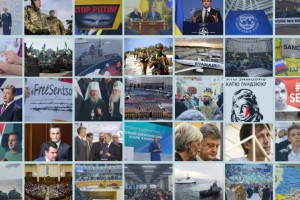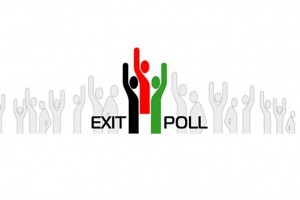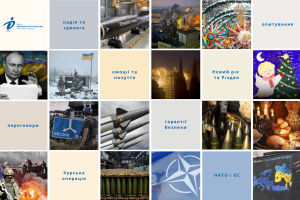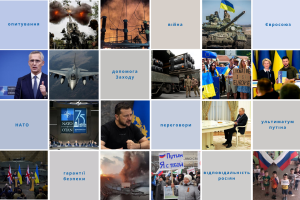War in Donbas and Russian Aggresssion. How Ukrainian Public Opinion Has Changed After Two Years of Zelenskyi's Presidency. Key points and observations
Representative nationwide research conducted by the Democratic Initiatives Foundation in cooperation with the sociologic service of Razumkov Center from 14th to 19th of May 2021 across all regions except Crimea and Donetsk/Lugansk occupied territories. 2020 respondents over 18 years of age have been surveyed. The theoretical sample error is no more than 2.3%
- Most Ukrainians (53.5%) define the Donbas armed conflict as Russian aggression with the use of local proxies against Ukraine. Furthermore, the number of supporters of this perspective in the last 18 months has grown from 45%. Despite this view’s popularity in the West and Center of Ukraine, popularity of this precise definition has grown over the last 1.5 years across all macro regions, including the East and the South. In comparison to November of 2019, number of people supporting this definition in the West has risen from 64% to 74%, in the Center – from 54% to 62%, the South – from 22% to 31%, and in the East – from 24% to 31% respectively.
- Other perspectives enjoy a significantly smaller amount of support, for example: “an internal conflict in Ukraine, one side of which is supported by Russia” (15%), “a war between Russia and the West on Ukraine’s soil” (13%), “a strictly internal civil conflict in Ukraine” (7%). The “an internal conflict in Ukraine, one side of which is supported by Russia” frame is more prevalent in the East and South of Ukraine. More accurately, 27% of the Eastern and 25% of the Southern population think this way. In contrast, support for the “a strictly internal civil conflict in Ukraine” narrative has decreased since 2019 in the South (from 22% to 11%) as well as in the East (from 21% to 15%).
- Within the electoral dimension, the “Russian aggression against Ukraine” definition enjoys absolute majority support of “Sluga Narodu” (64%), “European Solidarity” (76%) and “Bat’kivshchyna” (63.5%). Only OPFL members tend towards the “internal conflict” perspective: either with Russia’s support (32%), or as strictly civil conflict (24.5%).
- 71% of the population are assured that Ukraine and Russia are at war with each other. This view prevails from East (49%) to West (91%). Most of Volodymyr Zelensky’s (85%), Petro Poroshenko’s (88%) and Yuliya Timoshenko’s (76%) voters agree to this. Only 30% of Yuriy Boyko’s voters agree with the statement while 50% of his constituents deny that there is a war between the two.
- Russia’s role lies in controlling the so-called “LPR” and “DPR” and managing their political and military action (48%), Russian Armed Forces partaking in combat actions on the side of the so-called “LPR” and “DPR” (47%) and providing them with armament (43%). These three perspectives on Russia’s role prevail in the West, the Center and the South. Meanwhile, the East is largely undecided. In the East, each of these statements enjoy popularity between 31-38% of the local populous. Besides, 35% of the population presume that Russia provides humanitarian aid to CADR/CALR (Conflict-affected Donetsk/Luhansk Regions), 27% - that Russia is supporting the pseudo republics in a diplomatic way only.
- Public opinion has not yet reached unanimity regarding achieving long-standing peace in Donbas. Ideas of continued diplomatic pressure on Russia and “D/LPR”, increasing intensity of all possible sanctions (20%) or increasing Ukraine’s economic and military capabilities, complete isolation of the occupied territories (19%) are equally as popular. Additional 20% are unsure as to how to achieve stable peace in the region. In general, majority of Ukrainian public endorses forceful approach toward Russia, a combination of diplomatic, political and military tools.
Within this context, direct negotiations with the self-proclaimed republics enjoy only 13% of support, while in the East this variable is higher – 24%.
- The public absolutely rejects the idea of de-facto leaving Crimea “in exchange” for partial or complete regulation of the situation in Donbas. Only 7% of respondents think that a lasting peace in Donbas is achievable through concessions to Russia, such as Donbas’ full autonomy, and rejection of returning Crimea. Even less, 3% of the public think that an official agreement to Crimea’s annexation is the key to peace in Donbas.
- The public empathizes with residents of the government-uncontrolled territories of Donbas. The respondents believe that residents of temporarily occupied territories are prisoners of tough life circumstances (40%) or the militiamen themselves (9%). Other views on CADR/CALR residents are largely uncommon. 16% consider them to be passive supporters of “russian peace” and the USSR, 13% - adapters, 8% - traitors.
- Only 18% of Ukrainians think that agreement to any compromise is worth of the peace. 46% more believe not every compromise is worth achieving peace. Despite this position remaining the most widespread, it has seen great change on a regional level. More accurately, polarization of ideas can be observed in the Western macroregion.
Today, the perspective of selective compromise (37%) is equally as popular as the radical view – peace from position of power, when one of the sides wins. Furthermore, the “compromising” narrative has lost close to 20% of support when compared to 2019. The East’s public feeling has seen some change as well. Support for “selective compromises” has fallen from 66% in November 2020 to 39% in May of 2021. In addition, the “any compromise” perspective has gained traction, from 18% to 33% respectively. In the Center and the South, the views are more stable: mostly opting for “selective compromise” (52% and 60% respectively).
- The tendency to tougher policy in regard to the occupied territories has been somewhat strengthened in the society. Today, 30% believe that the territories need to be considered occupied, halt any form of trade, payouts, limit service provisions and movement of people. 21% support the economic “blockade” if diplomatic ties are kept. 10% believe in the viability of limited trade and diplomatic ties. However, in June of 2017, all of the positions were equally supported in the society (22-23%). Support for open economic and other relations with ORDLO has stayed the same as in June 2017 – 15%.
- Russian government’s unwillingness and denial to cooperate is believed to ruin any peace in Donbas. This opinion is shared by 62% of respondents. Only 19% blame the Ukrainian side for unwillingness to end the war and implement the Minsk agreements, most of them – residents of the East (35% of the macroregion) and the South (27%) and constituents of the pro-Russian party “Opposition Platform – For Life”.
- Majority of Ukrainians, 55% see political future of the temporary occupied territories as a part of Ukraine. Furthermore, this position gains absolute or comparative majority over others in every macro region. 13% each believe in regaining these territories under autonomy of some kind of other independence from Kyiv. The idea of the self-proclaimed groups’ complete independence or becoming part of Russia, as always, retains minimal support on the error level.
- Only 17% of Ukrainians support conducting elections on the occupied territories without any special conditions. The majority believes the elections should be held after the Russian troops pull out and the proxy troops are disarmed (25%) or several years after the territories are back under Ukraine’s control (28%). “Sluga narodu”, “ES” and “Bat’kivshchyna” voters favor the latter. Only OPFL favor holding elections with no safety conditions.
- 38% of Ukraine’s population support the President’s conflict settlement efforts, 19% - do not. Other 28% - are not informed on these efforts. Regionally speaking, the President enjoys support everywhere except the East. The number of his supporters and opponents there is almost tied: 28.5% and 31% respectively. Other 25% know nothing about the Presidents efforts in settling the conflict.
- As always, Ukraine’s citizens consider unacceptable most compromises proposed by Russia referencing the Minsk arrangements. The least accepted is the idea of holding elections on militia’s terms (unacceptable for 70%, acceptable only for 12%), amnesty of all combatants who fought against Ukrainian servicemen (66% vs. 15%), special economic and political relations between CADR/CALR and Russia (64% vs. 15.5%), and recruitment of only local representatives into law enforcement agencies (61% vs. 20%).
In the regional dimension, respondents from the eastern and southern regions are the most willing to compromise:
– 45% and 46% respectively believe inscribing CADR/CALR “special status” into the Constitutions as acceptable;
60% of southern population are willing to accept Ukraine’s neutral or non-bloc status;
giving Russian language status of a national language is supported by 66% of the South and 55% of the East;
almost to half the population of both regions are willing to accept direct negotiations with the so-called “LPR ”and “DPR”;
while 48% of the Eastern population are supportive of renewing trade with the occupied territories.
- At the same time, people from the eastern regions became somewhat antagonistic of certain compromises. Since 2019, fraction of those accepting Ukraine’s non-bloc or neutral status has decreased (from 60% to 50%), full amnesty (from 36% to 21%) and direct negotiations with the so-called “DPR” and “LPR” (from 64% to 49%).
- Compared to November 2019, unacceptance of special economic and political relations between CADLR (Temporary occupied territories of Donetsk and Luhansk regions) and Russia has grown significantly: from 50% to 64%. This tendency is present across all macro regions of Ukraine.








